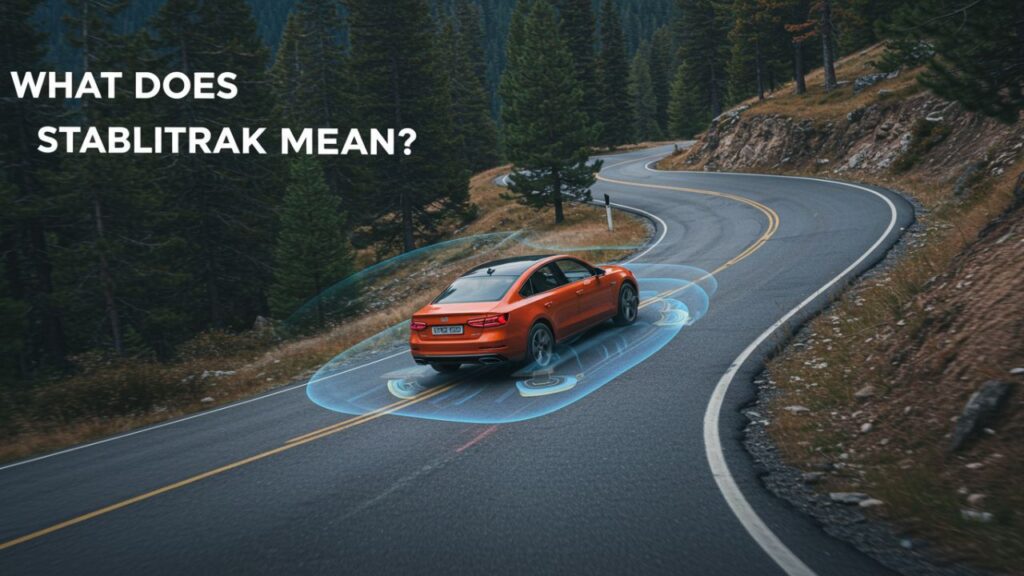Introduction
If you’ve ever driven a General Motors (GM) vehicle and seen the StabiliTrak warning light flash on your dashboard, you might have asked yourself, “what does StabiliTrak mean?” This advanced system plays a crucial role in ensuring your vehicle stays stable, especially in poor driving conditions. In this article, we’ll break down what StabiliTrak is, how it works, why it’s important, and what to do when it malfunctions.
What Does StabiliTrak Mean?
A Definition for Drivers
So, what does StabiliTrak mean in simple terms? StabiliTrak is General Motors’ proprietary Electronic Stability Control (ESC) system. It’s designed to help drivers maintain control of their vehicles during extreme steering maneuvers, sudden swerves, or when driving on slippery roads. In essence, StabiliTrak helps prevent skidding and loss of traction by adjusting braking and engine power automatically.
While StabiliTrak is mostly found in GM vehicles like Chevrolet, GMC, Cadillac, and Buick, it’s similar to ESC systems offered by other automakers. However, StabiliTrak stands out for its responsiveness and integration with other vehicle safety technologies.
How Does StabiliTrak Work?
Behind the Technology
To better understand, it’s essential to look at how the system functions. StabiliTrak uses a network of sensors to monitor the steering angle, wheel speed, yaw rate (how much the vehicle is rotating), and lateral acceleration.
If the system detects that your vehicle is not going in the direction you’re steering — for example, if you’re sliding sideways during a sharp turn — it intervenes by:
-
Applying brakes to individual wheels
-
Reducing engine power
-
Re-aligning traction and control
These interventions are automatic and often imperceptible to the driver, but they make a significant difference in keeping the vehicle on its intended path.
Why Is StabiliTrak Important?
Safety Comes First
Understanding is also about understanding its value. StabiliTrak enhances driver safety, especially in conditions that compromise traction, such as rain, snow, or gravel roads.
Here’s why the system matters:
-
Helps prevent rollover accidents
-
Minimizes risk of fishtailing or spin-outs
-
Improves stability during towing
-
Assists during emergency maneuvers
According to the National Highway Traffic Safety Administration (NHTSA), ESC systems like StabiliTrak can reduce fatal single-vehicle crashes by up to 49%.
Common StabiliTrak Warning Signs
When Something Goes Wrong
If you’re still asking, especially when the warning light turns on, you’re not alone. The StabiliTrak light usually appears when the system is either turned off or malfunctioning.
Here are some common reasons the StabiliTrak warning light may appear:
-
Sensor malfunction (wheel speed, yaw, or steering angle sensors)
-
ABS (Anti-lock Braking System) issues
-
Low battery voltage or alternator problems
-
Software glitches
-
Traction control system conflicts
When this warning light appears, it’s essential to diagnose the issue quickly. While the vehicle may still be drivable, its stability systems will not function correctly, increasing the risk of losing control in slippery or emergency situations.
What to Do When the StabiliTrak Light Comes On
Step-by-Step Solutions
If you’re wondering when it activates unexpectedly, follow these steps:
-
Pull Over Safely: Don’t panic. Slow down and pull over when it’s safe to do so.
-
Turn Off and Restart the Engine: Sometimes, a system reset clears the warning light.
-
Check for Other Dashboard Lights: Are ABS or check engine lights also on? That could point to a deeper issue.
-
Drive Carefully: If the light stays on, reduce speed and avoid aggressive turns.
-
Get a Diagnostic Scan: Visit a mechanic or auto parts store to scan the vehicle’s onboard diagnostic (OBD-II) system.
Fixing the system might be as simple as replacing a faulty sensor or could require a more in-depth electrical repair. Either way, addressing the issue promptly ensures you maintain full safety features.
StabiliTrak vs. Traction Control
Are They the Same?
Many drivers confuse StabiliTrak with traction control, so it’s worth clarifying. While both systems work together, they serve different functions.
-
Traction Control limits wheel spin during acceleration.
-
StabiliTrak maintains directional control during sudden maneuvers or skidding.
In short, traction control keeps you moving forward; StabiliTrak keeps you from veering off course.
Can You Drive?
Yes, But Should You?
Technically, you can drive a car with the StabiliTrak system disabled or malfunctioning. However, doing so comes with risks, especially in inclement weather or emergency conditions.
If you’re asking, for daily driving, the answer is: peace of mind. With the system functioning, you’re better protected from accidents caused by oversteering, understeering, or losing traction on uneven surfaces.
Newer Vehicles
Upgraded Safety Tech
Modern GM vehicles feature upgraded versions of StabiliTrak integrated with other systems like:
-
Lane Departure Warning
-
Adaptive Cruise Control
-
Collision Avoidance Systems
These systems work together to enhance vehicle handling and driver assistance. Understanding in newer vehicles is about seeing it as part of a broader safety ecosystem.
Final Thoughts
A System Worth Understanding
So, in the grand scheme of vehicle safety? It’s a critical system that actively helps prevent accidents by keeping your car stable and on track. Whether you’re navigating slick roads or reacting to a sudden swerve, acts as a hidden co-pilot, working behind the scenes to maintain control.






